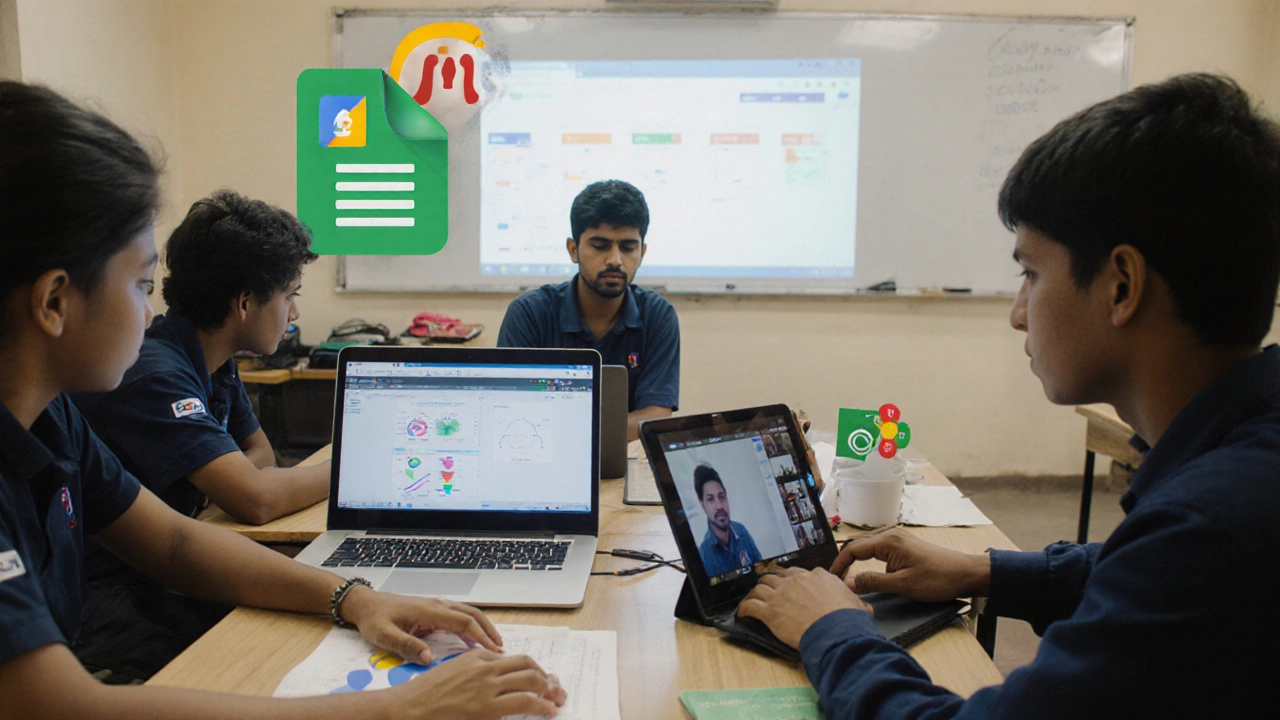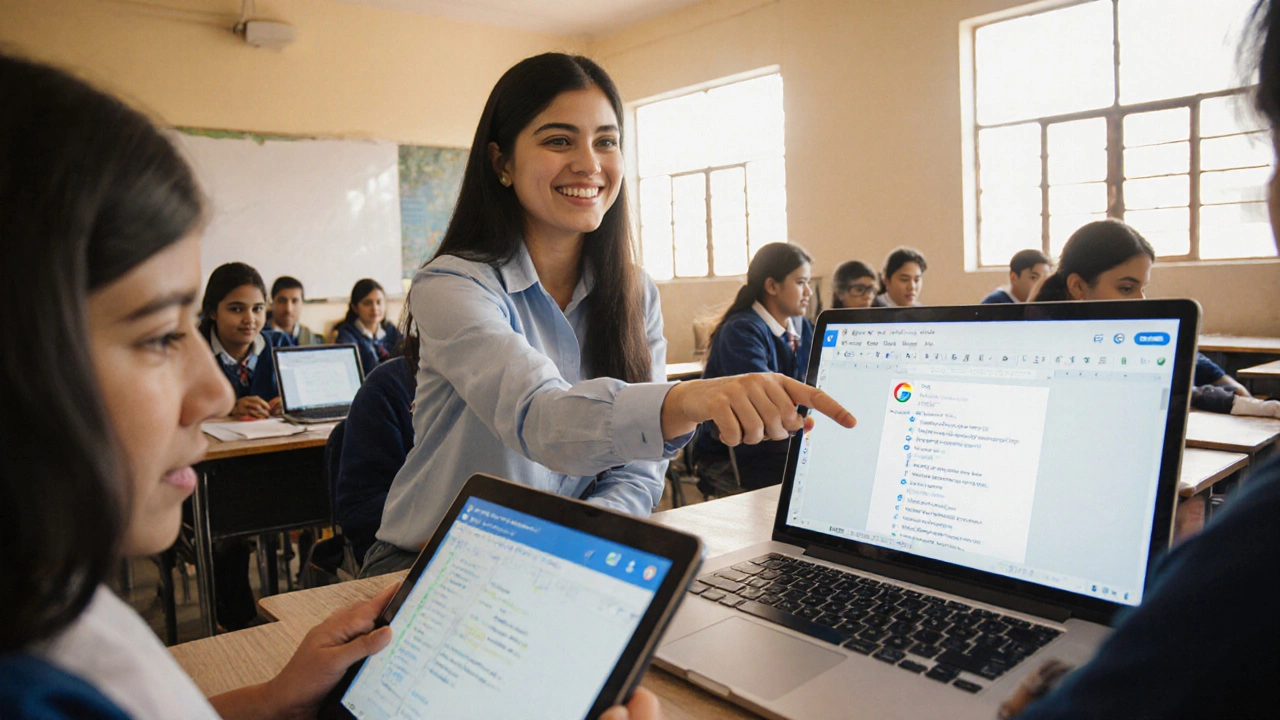Google Education Platform isn’t a single app. It’s a collection of free tools schools and teachers use every day to teach, assign work, and keep students engaged - all without paying a dime. If you’ve ever used Google Classroom to hand out homework or shared a Doc with your class, you’ve already used it. But what exactly is it, and why do over 150 million students and educators worldwide rely on it?
What’s Inside Google Education Platform?
Google Education Platform, officially called Google for Education a suite of cloud-based tools designed for schools, colleges, and universities to streamline teaching and learning, includes apps most people already know: Gmail, Drive, Docs, Sheets, Slides, Calendar, and Meet. But the real heart of it is Google Classroom a free learning management system that lets teachers create classes, distribute assignments, and give feedback in one place.
Unlike paid platforms like Blackboard or Canvas, Google for Education doesn’t lock you into expensive licenses. Schools sign up for a free tier called Google Workspace for Education Fundamentals a no-cost version offering core tools like Classroom, Drive storage, and Meet with up to 100 participants. Many schools upgrade to Google Workspace for Education Standard a paid version with advanced security, analytics, and more storage or Teaching and Learning Upgrade a subscription that adds quiz tools, assignment grading, and plagiarism checks - but the basics are always free.
How Do Teachers Actually Use It?
Imagine you’re a high school teacher in New Zealand. You need to assign a science project. Instead of emailing files, printing handouts, or using a clunky LMS, you open Google Classroom. You click "Create Assignment," attach a Google Doc with instructions, set a due date, and hit "Assign." Students see it instantly on their phones or tablets. They open the doc, type their answers, and submit. You grade it right there with comments, highlight mistakes, or add voice notes. No printing. No lost papers. No chasing down late submissions.
That’s the everyday magic. Teachers use:
- Google Classroom to organize assignments, announcements, and due dates
- Google Docs for collaborative writing - students can edit together in real time
- Google Forms to create quick quizzes, exit tickets, or feedback surveys
- Google Meet for virtual office hours, guest speakers, or remote learning days
- Google Drive to store all student work in one secure, searchable folder
And because everything’s in the cloud, students can work from home, the library, or even a bus ride. No need to install software. No login headaches. Just sign in with their school email and go.
What About Students?
For students, Google Education Platform means less stress and more freedom. You don’t need a fancy laptop. A Chromebook, iPad, or even an old Android phone works fine. Your work follows you wherever you go. Need to finish an essay after soccer practice? Open your Drive. Need to study for a test? Use Google Slides to make flashcards. Need to ask your teacher a question? Send a comment right on the assignment.
Teachers can also use Google Assignments a tool built into Classroom that lets teachers create quizzes, auto-grade multiple choice, and give instant feedback. That means students get results faster. No waiting days for a paper back. They see where they went wrong and can fix it before the next test.
It’s not just about convenience. It’s about building digital habits. By using these tools daily, students learn how to collaborate online, manage deadlines, and organize digital files - skills they’ll use in college and jobs.

How Is It Different From Other Learning Platforms?
Many schools use platforms like Microsoft Teams for Education, Canvas, or Schoology. So what makes Google stand out?
| Feature | Google for Education | Other Platforms (e.g., Canvas, Schoology) |
|---|---|---|
| Cost | Free core tools; paid upgrades available | Often requires annual licensing fees |
| Ease of Use | Simple interface, familiar tools | More complex, steeper learning curve |
| Device Compatibility | Works on any device with a browser | May require specific apps or plugins |
| Integration | Seamless with Gmail, Drive, Meet | Often isolated from other tools |
| Real-Time Collaboration | Multiple students edit Docs/Sheets at once | Usually limited to one user at a time |
Google’s biggest edge? It doesn’t feel like a school tool. It feels like the apps you already use to text friends or watch videos. That’s why students adapt faster. Teachers don’t need weeks of training. And schools save thousands on software licenses.
Who Uses It?
It’s not just for high schools. From kindergarten classrooms in rural Australia to universities in Canada, Google for Education is everywhere. In New Zealand, over 80% of public schools use Google Classroom. In the U.S., districts like Chicago Public Schools and Los Angeles Unified rely on it for millions of students.
Even special education teachers use it. Google’s built-in accessibility tools - like screen readers, voice typing, and live captions in Meet - help students with learning differences stay on track. Teachers can adjust font sizes, use color contrast modes, or record audio instructions for students who learn better by listening.
And it’s not just for students who have devices at home. Many schools loan out Chromebooks. Libraries and community centers offer free Wi-Fi and computer access. Google’s tools are designed to work even with slow internet - you can download assignments to work offline and sync later.
Common Misconceptions
Some people think Google for Education is just "Google Classroom." It’s not. Classroom is just one piece. The real power is how everything connects. Your student’s essay in Docs gets saved to Drive. You comment on it in Classroom. They reply using Gmail. You schedule a help session with Meet. All of it lives together.
Others worry about privacy. Google doesn’t sell student data. Schools control what data is shared. Google’s agreements with educational institutions require them to use student data only for learning purposes. You can check your school’s privacy policy - most publish it online.
And no, you don’t need to be tech-savvy. Google offers free training videos, lesson plans, and certification programs for teachers. Many schools have a tech coach who helps teachers get started. You don’t need to be a programmer. You just need to know how to open a browser.

Getting Started
If you’re a teacher and your school hasn’t signed up yet, ask your IT department about Google Workspace for Education Fundamentals. It’s free. No credit card needed. If you’re a parent, ask if your child’s school uses Google Classroom. If they do, you’ll get an email with a link to view assignments (though you can’t edit anything - that’s just for students and teachers).
For students: your school will give you a username and password - usually your name followed by @yourschool.edu.nz or similar. Log in at classroom.google.com. That’s your hub.
And if you’re curious, try it yourself. You can sign up for a free personal Google account and create a fake classroom to play around. It’s the best way to learn.
What’s Next for Google Education?
Google keeps adding new features. In 2025, they rolled out AI-powered tools like Assignment Coach an AI tool that helps students break down big projects into smaller steps and track progress. There’s also better translation tools for multilingual classrooms and smarter feedback suggestions in Docs.
But the core hasn’t changed: make learning easier, more connected, and more human. No gimmicks. No ads. Just tools that help teachers teach and students learn.
Is Google Education Platform free for schools?
Yes, Google offers a free version called Google Workspace for Education Fundamentals. It includes Classroom, Drive, Docs, Meet, and other core tools with no cost. Schools can upgrade to paid versions for more storage and advanced features, but the basic tools are always free.
Do students need a Google account to use it?
Yes, but not a personal one. Schools create managed Google accounts for students using their school email addresses. These accounts are controlled by the school and don’t show ads or allow personal data collection. Students can’t sign up on their own - they’re provided by the school.
Can parents access Google Classroom?
Parents can’t log in or edit assignments, but teachers can invite them to receive email summaries of their child’s upcoming assignments and missing work. This feature is called "Guardian Summaries" and must be turned on by the teacher.
Is Google Classroom the same as Google for Education?
No. Google Classroom is just one tool within the larger Google for Education suite. Google for Education includes Classroom, Drive, Docs, Meet, Forms, and other tools that work together. Classroom is the main hub for assignments, but the other tools make it powerful.
Can students use Google Education Platform without Wi-Fi?
Yes. Google Docs, Sheets, and Slides can be used offline if enabled ahead of time. Students can download assignments, work on them without internet, and sync changes once they’re back online. Many schools provide offline access instructions for students without reliable home internet.
Final Thoughts
Google Education Platform isn’t flashy. It doesn’t have holograms or AI tutors that talk like robots. But it works. It’s simple. It’s free. And it’s used by millions of real classrooms every day. If you’re looking for a way to stop printing papers, reduce chaos, and help students stay organized - this is it. No training required. No budget needed. Just open a browser and start teaching.
